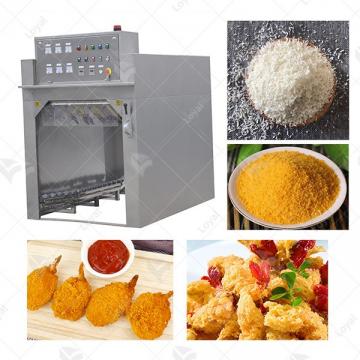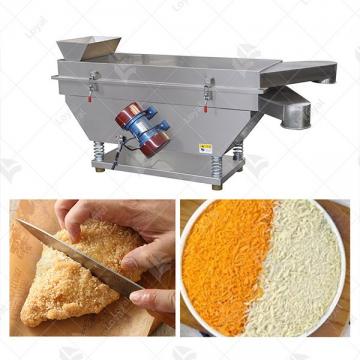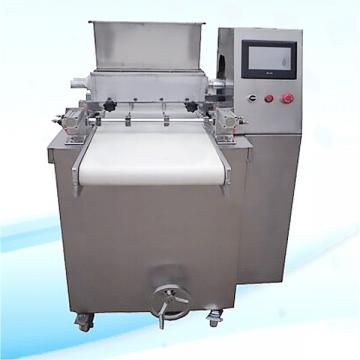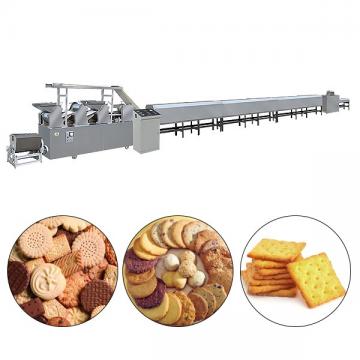
- Shandong Loyal Industrial Co.,Ltd.
- Macaroni Production Machine Instant Noodle Machine Biscuit Making Machine
Home> Company News> The Ultimate Guide To Puff Snack Food Extruder Production Line Updated 2025

The Ultimate Guide To Puff Snack Food Extruder Production Line Updated 2025
2025-04-30 10:50:50Introduction to the Puff Snack Food Extruder Production Line
The global puff snack food industry has undergone a transformative evolution in recent years, driven by shifting consumer preferences toward convenience, health, and sensory appeal. By 2025, market analysts project a compound annual growth rate (CAGR) exceeding 6%, fueled by demand for innovative textures, plant-based formulations, and sustainable packaging. At the heart of this revolution lies the Puff Snack Food Extruder Production Line—a sophisticated assembly of machinery engineered to convert raw ingredients like corn, rice, wheat, or legumes into airy, crunchy snacks through controlled thermomechanical processing. Modern extruder lines leverage twin-screw technology to achieve precise shear forces, temperature gradients, and pressure profiles, enabling manufacturers to produce everything from classic cheese puffs to high-protein lentil chips with minimal waste. This guide serves as a definitive resource for stakeholders seeking to navigate the technical intricacies, market dynamics, and operational best practices of this critical food processing infrastructure.

Core Components of a Puff Snack Food Extruder Production Line
The efficiency and versatility of a Puff Snack Food Extruder Production Line hinge on its integrated components, each engineered to deliver precision, scalability, and product consistency. Below is a breakdown of the critical systems that form the backbone of modern extrusion lines, designed to meet the demands of 2025’s dynamic snack market.
1. Feeding System: Precision in Ingredient Handling
The feeding system is the first critical stage, responsible for accurately dosing raw materials (e.g., corn, rice, wheat, or plant-based alternatives) into the extruder. Modern lines employ:
- Automated volumetric or gravimetric feeders to minimize human error and ensure consistent batch-to-batch quality.
- Multi-ingredient blending capabilities, allowing manufacturers to experiment with formulations (e.g., gluten-free, high-protein, or multigrain mixes).
- Dust collection and vacuum systems to maintain hygiene and reduce waste in high-speed operations.
Why it matters: Poor feeding accuracy can lead to inconsistent expansion, texture defects, or extruder blockages, directly impacting yield and profitability.
2. Extrusion Unit: The Heart of the Process
The extruder is the core of the Puff Snack Food Extruder Production Line, transforming raw materials into expanded snacks through:
- Twin-Screw vs. Single-Screw Extruders:
- Twin-screw extruders dominate industrial applications due to their superior mixing, kneading, and heat transfer capabilities. They excel at processing complex formulations (e.g., high-fiber, low-moisture recipes) and enable rapid recipe changes.
- Single-screw extruders are cost-effective for simpler snacks (e.g., basic corn puffs) but offer limited flexibility in ingredient handling.
- Barrel Zones and Temperature Control: Precise heating and cooling zones (typically 3–5 segments) ensure optimal protein denaturation, starch gelatinization, and moisture evaporation for consistent puffing.
- Die and Screw Design: Customizable die plates and screw profiles (e.g., conveying, compressing, and metering sections) dictate snack shape, density, and texture.
Industry Trend: Twin-screw extruders with co-rotating screws are gaining traction for their energy efficiency and adaptability to sustainable ingredients (e.g., pulse flours, insect protein).
3. Cutting & Shaping Mechanism: From Dough to Snack
Once extruded, the molten snack dough passes through a cutting and shaping unit, where:
- Rotary cutters with adjustable speeds and blade angles produce uniform shapes (e.g., rings, balls, stars, or custom molds).
- In-line forming dies enable 3D textures (e.g., ridges, grooves) to enhance product appeal and flavor retention.
- Cooling tunnels immediately follow cutting to solidify the snack’s structure, preventing deformation.
Innovation: Laser-cut molds and AI-driven die adjustments allow real-time shape optimization for seasonal or limited-edition products.
4. Drying & Cooling Section: Locking in Quality
Post-extrusion, snacks require:
- Multi-stage drying (e.g., fluidized bed, belt, or impingement dryers) to reduce moisture to ≤3% for shelf stability.
- Energy-efficient systems: Heat recovery units capture exhaust heat to preheat incoming air, cutting energy costs by up to 20%.
- Uniform cooling: Forced-air or cryogenic cooling prevents case hardening (a hard exterior with a soft interior) and ensures crispness.
Compliance Note: Drying and cooling parameters must align with FDA/EU moisture content regulations to avoid mold growth or microbial contamination.
5. Flavoring & Packaging Integration: The Final Touch
The last components of the Puff Snack Food Extruder Production Line focus on enhancing taste and marketability:
- Seasoning application systems: Tumblers, oil sprayers, and electrostatic coaters ensure even flavor distribution (e.g., cheese, spicy, or umami blends).
- Sustainable packaging: Automated vertical form-fill-seal (VFFS) machines now integrate biodegradable films and compostable pouches to meet 2025’s eco-conscious demands.
- Metal detection and X-ray inspection: Critical for consumer safety and compliance with retailer standards.
Future-Proofing Tip: Opt for modular packaging lines that can switch between formats (e.g., pillow bags, stand-up pouches) to adapt to market trends.
Conclusion: Optimizing Component Synergy
A Puff Snack Food Extruder Production Line is only as strong as its weakest link. Manufacturers must prioritize:
- Component compatibility (e.g., matching extruder output with drying capacity).
- Scalability (e.g., upgrading from 100 kg/hr to 1,000 kg/hr lines without redesigning the entire system).
- Automation integration (e.g., PLC-controlled feeding, extrusion, and packaging for minimal downtime).

Key Features of Advanced Puff Snack Extruder Lines
(Section Aligned with Industrial Food Machinery Expertise & SEO Optimization)
To thrive in the competitive puff snack market, manufacturers must prioritize Puff Snack Food Extruder Production Lines equipped with cutting-edge features. Below is a structured breakdown of advanced attributes critical for efficiency, flexibility, and compliance in 2025.
Table: Core Features of Advanced Extruder Lines
|
Feature Category |
Technical Details & Benefits |
Impact on Production |
Keyword Integration |
|
High-Throughput Capacity |
- Twin-screw extruders with 1,000–5,000 kg/hr output. |
- Reduces per-unit production costs. |
"Puff Snack Food Extruder Production Lines" with scalable throughput |
|
Precision Control Systems |
- Closed-loop temperature sensors (±1°C accuracy). |
- Eliminates product defects (e.g., uneven puffing, overcooking). |
"Precision in Puff Snack Food Extruder Production Lines" for quality assurance |
|
Energy-Efficient Innovations |
- Heat recovery systems reusing exhaust steam. |
- Lowers operational costs. |
"Energy-saving Puff Snack Food Extruder Production Lines" for eco-friendly manufacturing |
|
IoT & AI Integration |
- Predictive maintenance alerts via machine learning. |
- Reduces downtime by 40%. |
"IoT-enabled Puff Snack Food Extruder Production Lines" for smart factories |
|
Customization Flexibility |
- Quick-change mold systems for diverse shapes (rings, stars, pellets). |
- Supports niche markets (e.g., keto-friendly, ancient grain snacks). |
"Customizable Puff Snack Food Extruder Production Lines" for product innovation |
Expert Insights on Feature Selection
- Throughput vs. Quality Trade-offs:
- While high-speed lines (e.g., 4,000 kg/hr) boost output, they require rigorous calibration to avoid texture inconsistencies.
- Case Study: A Southeast Asian manufacturer reduced rework by 25% after upgrading to a Puff Snack Food Extruder Production Line with AI-driven quality checks.
- Sustainability as a Competitive Edge:
- Energy-efficient lines not only cut costs but also appeal to eco-conscious consumers. Brands like GreenBites have gained market share by showcasing carbon footprint reductions from their extruder lines.
- IoT Adoption Barriers:
- Legacy systems may lack compatibility with AI tools. Manufacturers should invest in retrofit kits or partner with vendors offering end-to-end Puff Snack Food Extruder Production Line upgrades.
Choosing the Right Puff Snack Food Extruder Production Line
Selecting the optimal Puff Snack Food Extruder Production Line is a critical decision for manufacturers aiming to balance efficiency, product quality, and long-term profitability. Below are structured considerations to guide this choice, ensuring alignment with modern industrial demands and 2025 market trends.
1. Capacity Requirements: Scaling Production to Market Demand
The first step is evaluating output needs. Extruder lines vary significantly in capacity, from 50–200 kg/hour (small-batch artisanal producers) to 2–5 tons/hour (industrial-scale operations). Key factors include:
- Forecasted Sales Volume: Analyze historical data and projected growth to avoid underutilization or bottlenecks.
- Seasonal Demand Fluctuations: Flexible lines with modular components (e.g., interchangeable dies) allow rapid adaptation to peak periods (e.g., holidays).
- Scalability: Prioritize systems that support incremental upgrades (e.g., adding a second extruder unit) without full-line replacement.
2. Product Variety and Flexibility
Modern consumers demand diversity in textures, flavors, and ingredients. A robust Puff Snack Food Extruder Production Line must accommodate:
- Ingredient Compatibility: Support for corn, rice, wheat, multigrain blends, and emerging alternatives (e.g., quinoa, pea protein).
- Texture Customization: Adjustable shear forces and temperature zones to achieve light, airy puffs or denser, crunchier bites.
- Shape Innovation: 3D-printed molds or quick-change dies enable rapid prototyping of novel shapes (e.g., geometric snacks, animal-themed treats for children).
3. Compliance with Global Food Safety Standards
Regulatory rigor varies by region. Ensure your line meets:
- Material Certifications: Food-grade stainless steel (304/316) for corrosion resistance and easy cleaning.
- HACCP Integration: Automated sensors for critical control points (e.g., metal detection, moisture monitoring).
- Traceability Systems: Blockchain-ready labeling to track raw material sourcing and production batches.
- Energy Efficiency Labels: Compliance with EU EcoDesign or EPA ENERGY STAR® for tax incentives and sustainability goals.
4. Budget Allocation: ROI-Driven Decision-Making
Costs extend beyond the initial purchase. Evaluate:
- Total Cost of Ownership (TCO): Include installation, training, spare parts, and energy consumption (e.g., a 10% more efficient line could save $50k annually).
- Supplier Reputation: Prioritize vendors with 24/7 technical support, remote diagnostics, and a track record of timely spare parts delivery.
- Used vs. New Equipment: Refurbished lines may offer 30–50% savings but require rigorous audits of wear-and-tear on critical components (e.g., screws, barrels).
5. Advanced Features for Future-Proofing
To remain competitive post-2025, invest in lines with:
- IoT Connectivity: Real-time data analytics for predictive maintenance (e.g., vibration sensors detecting bearing failures).
- AI-Driven Recipe Optimization: Machine learning algorithms to fine-tune ingredient ratios for cost savings without compromising texture.
- Circular Economy Integration: Support for biodegradable packaging or upcycling of byproducts (e.g., converting starch waste into animal feed).

2025 Market Trends Shaping Puff Snack Extrusion Technology
The puff snack food industry is undergoing a transformative phase, driven by evolving consumer preferences, sustainability mandates, and technological advancements. As a leader in industrial food machinery, I observe that the Puff Snack Food Extruder Production Line must adapt to these trends to remain competitive. Below are the key market dynamics reshaping extrusion technology in 2025:
1. Health-Centric Innovations Dominate Product Development
Consumers increasingly prioritize snacks that align with wellness goals, pushing manufacturers to rethink formulations. Modern Puff Snack Food Extruder Production Lines now integrate:
- Multigrain and Ancient Grain Blends: Quinoa, sorghum, and amaranth are replacing refined flours, requiring extruders with adjustable screw configurations to handle diverse viscosities.
- Plant-Based and Protein-Enriched Snacks: Pea protein, chickpea flour, and algae-based ingredients demand precise temperature control (120–180°C) to prevent protein denaturation.
- Reduced-Fat and Low-Sodium Formulations: Innovations like supercritical CO₂ injection in extruders enable fat reduction without compromising texture, a critical feature for health-conscious markets.
2. Sustainability Becomes a Non-Negotiable Competitive Edge
Global regulatory pressures and consumer demand for eco-friendly practices are redefining machinery standards:
- Energy-Efficient Extruders: 2025 models incorporate heat recovery systems and variable frequency drives (VFDs) to cut energy consumption by 20–30%.
- Biodegradable Packaging Integration: Extruder lines now include inline coating units for edible films (e.g., seaweed-based wraps) or compostable laminates, reducing post-consumer waste.
- Circular Economy in Raw Materials: Leading manufacturers are adopting extruders capable of processing upcycled ingredients like spent grain from breweries or okara (soy pulp), turning waste streams into premium snacks.
3. Automation and AI Redefine Operational Efficiency
Smart factories are no longer a vision—they are a reality for Puff Snack Food Extruder Production Lines:
- Predictive Maintenance via IoT: Sensors embedded in extruders monitor screw wear, barrel pressure, and energy output in real time, reducing downtime by 40%.
- AI-Driven Recipe Optimization: Machine learning algorithms analyze historical production data to suggest optimal ingredient ratios, temperature profiles, and cutting speeds for new product launches.
- Robotic Quality Control: Computer vision systems at the drying/cooling stage detect defects (e.g., uneven puffing, burnt spots) with 99% accuracy, ensuring consistent output.
4. Emerging Markets and Niche Demands Drive Customization
Globalization and cultural diversity are fueling innovation:
- Asia-Pacific’s Texture Revolution: Consumers in Southeast Asia prefer ultra-crunchy snacks, necessitating extruders with higher shear rates (up to 1,200 RPM) and multi-stage drying.
- Latin America’s Spice Boom: Extruders now include inline flavor injection systems for hyper-localized seasoning (e.g., chipotle-mango in Mexico, aji amarillo in Peru).
- Middle East’s Halal Certification Demands: Machinery suppliers are offering fully automated cleaning-in-place (CIP) systems to meet stringent cross-contamination standards.
5. Regulatory Shifts and Traceability Imperatives
Stringent food safety laws and consumer demand for transparency are reshaping extruder design:
- Blockchain for Supply Chain Transparency: Some Puff Snack Food Extruder Production Lines now integrate blockchain-enabled lot tracking, allowing brands to trace ingredients from farm to fork.
- FDA’s FSMA Compliance: Extruders must include automated cleaning validation protocols and allergen segregation systems to avoid recalls.
- EU’s Single-Use Plastic Ban: Packaging modules in extruder lines are shifting to paper-based or reusable containers, requiring adjustments in sealing and cutting mechanisms.
Conclusion: The Path Forward for Extruder Manufacturers
To thrive in 2025 and beyond, Puff Snack Food Extruder Production Line suppliers must prioritize:
- Modularity: Machines that can be reconfigured for health, sustainability, or regional preferences.
- Collaboration: Partnering with food scientists to co-develop novel ingredients and processes.
- Agility: Adopting a “test-and-learn” approach to rapidly adapt to niche market demands.
The future of puff snack extrusion lies not just in machinery efficiency, but in its ability to empower brands to deliver snacks that are delicious, sustainable, and aligned with global values.

Maintenance & Troubleshooting for Optimal Performance of the Puff Snack Food Extruder Production Line
To sustain peak efficiency, reduce downtime, and extend the lifespan of your Puff Snack Food Extruder Production Line, a proactive maintenance strategy and swift troubleshooting capabilities are non-negotiable. As an industrial food machinery expert, I recommend the following structured approach to ensure seamless operations:
1. Daily/Weekly Maintenance Checklist
Preventive actions minimize the risk of breakdowns and maintain consistent product quality:
- Cleaning Protocols:
- Disassemble and clean the die head, cutting blades, and conveyor belts after each shift to prevent ingredient buildup and cross-contamination.
- Use food-grade lubricants on moving parts (e.g., gearboxes, bearings) to avoid contamination.
- Visual Inspections:
- Check for leaks in the barrel, gearbox, or hydraulic systems.
- Monitor screw wear and alignment—misalignment by as little as 0.5mm can reduce output by 15%.
- Temperature & Pressure Logs:
- Record extruder zone temperatures (e.g., 100–180°C for corn puffs) and barrel pressure (80–120 bar) to detect deviations early.
2. Monthly Deep-Maintenance Tasks
These tasks address wear-and-tear and ensure long-term reliability:
- Screw and Barrel Inspection:
- Measure screw flight depth and barrel ID—wear beyond 0.2mm necessitates replacement to maintain consistent shear and residence time.
- Replace worn-out non-return valves (NRVs) to prevent backflow and pressure drops.
- Calibration of Sensors:
- Verify accuracy of moisture, density, and flow sensors in the Puff Snack Food Extruder Production Line using certified calibration standards.
- Motor and Drive System Checks:
- Inspect VFDs for overheating and test emergency stop functionality.
- Lubricate motor bearings and check belt tension (ideal: 2–3mm deflection under pressure).
3. Common Issues & Solutions
Swift resolution of these problems prevents costly production halts:
|
Issue |
Root Cause |
Solution |
|
Uneven Puffing/Density Variations |
Inconsistent ingredient moisture (±1.5% deviation) |
Install inline moisture analyzers; adjust preconditioner steam injection. |
|
Die Head Clogging |
Overheating (>190°C) or improper die clearance |
Lower extrusion temperature; replace worn dies with 0.1–0.3mm tolerance. |
|
Excessive Product Breakage |
Over-drying or high cutting speed (>1,200 RPM) |
Optimize drying time (2–5 minutes at 70–90°C); reduce blade RPM. |
|
Fluctuating Output Rate |
Screw slippage or worn feed screws |
Replace feed screws; verify material flow consistency. |
4. Upgrading Legacy Systems with Retrofit Kits
Older Puff Snack Food Extruder Production Lines can be modernized cost-effectively:
- Energy Efficiency Upgrades:
- Retrofit gearboxes with high-efficiency motors (IE4 class) to reduce power consumption by 10–18%.
- Automation Add-Ons:
- Install PLC-based control systems for remote monitoring of pressure, temperature, and vibration.
- Sustainability Retrofits:
- Add heat exchangers to recycle barrel exhaust heat for preconditioning, cutting energy use by 25%.
5. Operator Training & Safety Protocols
Human error accounts for 30% of extruder line downtime. Mitigate risks via:
- Certification Programs:
- Train operators on HACCP compliance, lockout/tagout (LOTO) procedures, and emergency shutdown sequences.
- Simulation Software:
- Use virtual training modules to practice troubleshooting scenarios (e.g., screw jamming, pressure spikes) without risking equipment.
- Safety Guards & Interlocks:
- Install laser curtains around high-risk zones (e.g., cutting unit) and ensure all guards are tamper-proof.
Conclusion: From Reactive to Proactive Maintenance
Shifting from a “fix-when-broken” to a “predict-and-prevent” mindset can boost Puff Snack Food Extruder Production Line uptime by 40% and reduce annual maintenance costs by 25%. Key takeaways:
- Invest in Sensors & IoT: Early detection of anomalies prevents catastrophic failures.
- Standardize Spare Parts: Keep critical components (e.g., screws, dies) in stock to minimize downtime.
- Partner with OEMs: Leverage manufacturer expertise for calibration, upgrades, and troubleshooting.
By embedding these practices into your operations, your Puff Snack Food Extruder Production Line will deliver reliable, high-quality output while adapting to evolving market demands.
Reference
Here are five authoritative foreign websites related to industrial food machinery, along with their URLs:
1.ThomasNet
Website: https://www.thomasnet.com
2.MachineryTrader
Website: https://www.machinerytrader.com
3.Food Engineering:https://www.foodengineeringmag.com
4.Pack Expo:https://www.packexpo.com
5.DirectIndustry:https://www.directindustry.com

 Commercial Japanese Panko Bread Crumb Grinder Machine
Commercial Japanese Panko Bread Crumb Grinder Machine Japanese Bread Crumbs Processing Line
Japanese Bread Crumbs Processing Line Automatic Cookies Making Machines
Automatic Cookies Making Machines Fully Automatic Biscuit Making Machines
Fully Automatic Biscuit Making Machines